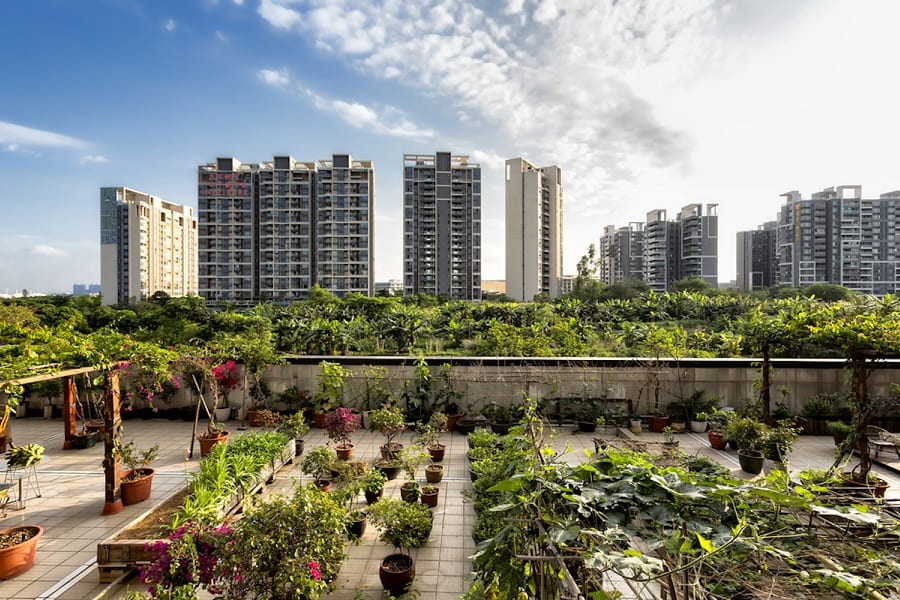If you’ve always dreamed of having a garden but don’t even live close to a square foot of grass, there’s no need to despair.
Urban gardening is your key to achieving it and it doesn’t have to be as basic and sad as a few hanging pots on your apartment balcony.
These days, urban gardening is a blossoming trend, and it means making the most of the urban landscape to grow everything from flowers to fruit in the city.
There are loads of ways to make it happen, whether it’s with a community plot or on your patio, and you don’t even need advanced gardening skills to start.
So, what is urban gardening all about?
Urban agriculture and gardening are about growing plants in a city environment. There are different types of urban gardening including rooftop and container growing, but it’s an all-encompassing term that covers all types of gardening done in an urban setting.
There’s no need to throw in your spade just because you no longer live in a rural area or don’t have a backyard, as you can learn a lot from urban gardening.
Taking advantage of the city is easier than you think, so everyone can benefit from the joys of gardening, no matter where they reside.
Table of Contents
What is Urban Gardening?
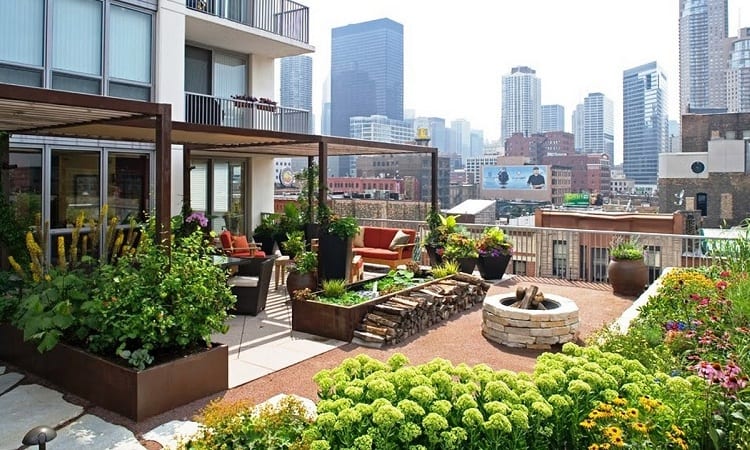
Urban gardening is a term used to describe the practice of growing plants in an urban setting.
This broad definition covers everything from community and rooftop gardens and in the middle of a bustling cityscape to someone with herbs on their patio or a few potted plants on their apartment balcony, and everything in between.
There are many aspects of urban gardening and it’s up to the gardener themselves to decide what route they want to take.
You might look around your local city and find that there are already some established plots or rooftop spaces, or that your neighbors have a growing garden on their balcony, and it’s never been a better time to join in.
Urban gardening is dispelling the myth that you need to have lush green grass or live in a suburban area just to exercise your green thumb.
By utilizing the city around you and taking advantage of space wherever you can, not only are you going to benefit from the act of gardening but you’ll be doing great things for the community as well.
The History of Urban Gardening
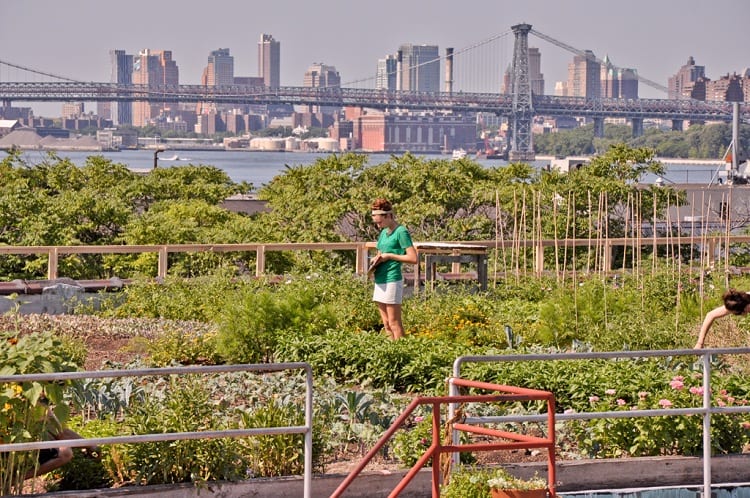
Although urban gardening appears to be a trending word in recent times, it’s been around a lot longer than now.
Urban gardening is most commonly referred to as urban agriculture when talking in a historical sense and it served many purposes throughout the years including food security, recreational hobby, and even as a tool for social reform.
There are many examples of urban agriculture throughout the world with one of the earliest coming from Mesopotamia where people would have their plots of lands inside the city’s walls, as well as the Hanging Gardens of Babylon.
In Ancient Egypt, fruit and nut trees were grown in the cities to provide produce and shade for its citizens where they might not be greenery otherwise.
In more modern history, examples like London showed that in the early 1900s the city would allocate lots of land for citizens to grow plants and food on for a small fee as a way to free them from poverty.
Countries like Australia, Germany, and the US had “victory gardens” or “war gardens” that allowed people to boost supplies of food by growing their own, as most rations had gone towards war efforts.
It’s believed that around 41% of vegetables consumed in 1943 in the US were from these very gardens.
Today, urban gardens are more plentiful than ever, even if they aren’t grown for such serious purposes as poverty and war.
However, the tools they give citizens can help them prepare for anything to come in the future as well as provide a relaxing pastime that has loads of other benefits for the now.
How It Impacts the Community
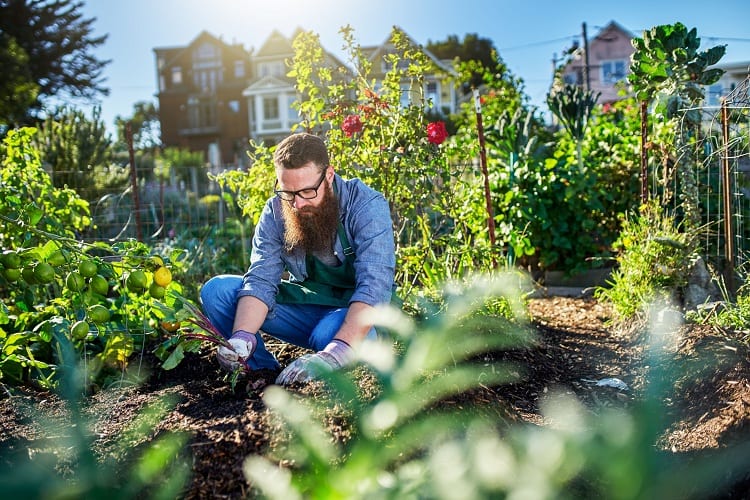
As you can see from history’s pages, there are lots of beneficial reasons to start an urban garden, and living in the middle of a thriving city shouldn’t deter you.
These are some of the benefits available to the community when public and urban gardens are started, and worth keeping in mind.
Improves air and soil quality
Any time a new plant is born, it does great things for the air and soil around it. Imagine then, the scope of thousands of people growing an urban garden and what it could do for the depleted quality of air and soil in the city.
Creates a sense of community
Working together with other members of a neighborhood in a shared garden or seeing that your neighbors are also growing plants on the rooftop or balcony is the perfect way to join together as a community and feel that you have a shared interest.
Increase fruit and vegetable consumption
Having access to fresh fruit and vegetables means you’re more likely to eat it as part of your regular diet. This can be especially helpful in low-income neighborhoods that might have limited access to nutritious foods, which then leads to issues of obesity and malnutrition.
Improve mental wellbeing
There’s nothing quite like gardening to help relax and promote mindfulness. People of all ages can use urban gardens as a space to improve their mental wellbeing and get in touch with nature, even in the middle of a bustling city.
Reduces community waste
When the community gets together to run a garden and introduces practices like composting, the overall waste production of the neighborhood will decrease.
If you consider that all neighborhoods in a city could be doing the same, you see how real change can be made with urban gardening.
Improve food security
Just like the historical examples, having urban gardens or community plots can help people secure their food sources. With access to fruit and vegetables that you’ve grown, you won’t have to rely as much on the supply chain that can be sometimes limiting and expensive.
The Types of Urban Gardens
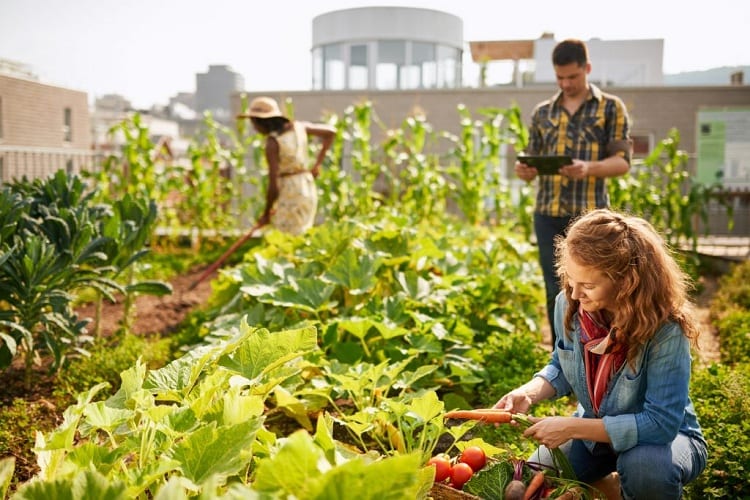
Most people have an idea in mind when they hear the term ‘urban garden’ and it usually conjures up images of a large community garden or something simple like a plant in a pot on your balcony.
There are, in fact, many ways you can grow an urban garden, so think about what would work best for you.
Rooftop garden
Many apartment buildings in cities have access to an open rooftop, and this can present the ideal space to start a garden. Before committing, you’ll need to check with the management of the building and research local laws to establish what’s allowed.
Vertical garden
A vertical garden can be grown up a wall, inside or out, and it’s the perfect way to make space when you might not have any. Look for plants like ferns, bromeliads, and succulents that do especially well in these types of structures.
Succulent garden
Many succulent varieties are known as hardy and low maintenance, making them perfect for the inner-city gardener who doesn’t want to spend a lot of time keeping plants alive.
You can go as small as a bowl centerpiece or have an entire succulent garden and they only need a container to survive.
Community garden
A community garden or plot is a shared space in a city that allows people to come and tend to it together, working as a community. There are many types of community gardens including herb gardens, children’s gardens, vegetable gardens, and more.
Herb garden
Herbs are small and wonderful, growing in a compact space that makes them ideal for the urban gardener. Even if you don’t have a patio, you can grow many herbs on a well-lit windowsill, giving you access to the farm-to-table experience on a miniature scale.
Vegetable patch
Growing vegetables in the city might seem like a conflicting notion, but it’s incredibly easy to do with any outdoor space. Use your patio, balcony, rooftop, or a community garden to grow some of the easier veggies at first before upgrading your skills.
Balcony garden
A balcony garden is any type of garden that exists on your balcony and it’s the best way for an urbanite to flex their green thumb. A balcony garden can be a few potted plants or completely cover your balcony with climbing vines, flowers, and a herb garden as well.
The Best Plants for an Urban Garden
When your goal for an urban garden is something you can keep on your balcony or plant in a small city space, there are some plants better than others for this purpose.
Keep these in mind when you’re investing in some plants for your inner-city greenery as they’re low maintenance and do well in these settings.
- Crab apple: Perfect for a small garden, these are compact trees that have bold colors all year round and will be a great centerpiece for a city setting.
- Cycad: The cycad is hardy and easy to grow but adds some texture to the city, whether it’s planted on your balcony in a large pot or as part of a garden.
- Topiary: This is not so much a plant but a practice, and it works for urban gardens well. Topiary is about trimming hedges and shrubs into clearly defined shapes and it’s a great way to learn a skill in gardening.
- Japanese maple: A fully grown Japanese maple can be between two and 30 feet tall so they’re perfect for compact spaces like city gardens. They have bright red leaves and are easy to care for as well.
- Herbs: Growing herbs is perfect on a balcony of a small city garden and gives you a delicious, freshly grown treat to incorporate every night into your cooking.
- Succulents: For the balcony or patio garden with minimal room, you can try your hand at succulent gardening. Succulents are ranging from simple to advanced in the care they require so they present a challenge for gardeners of all skill levels.
Equipment and Tools Required
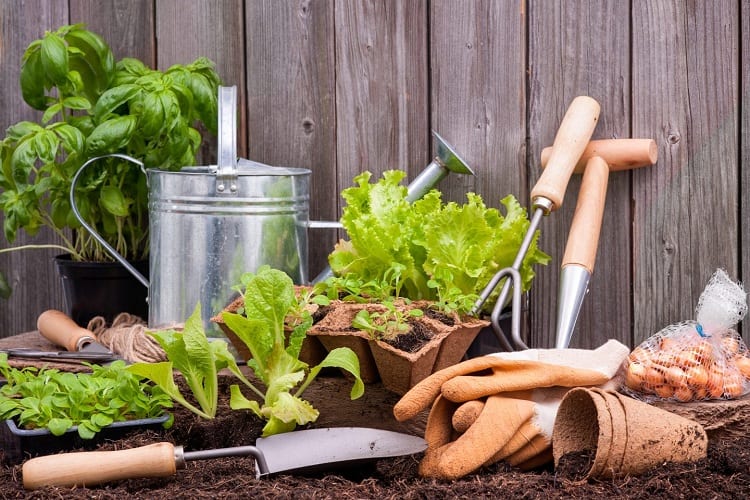
Urban gardening is a hobby that requires a few tools to get started, just as it would if you were starting a garden in your own backyard.
Depending on the type of garden you’re planning and its purpose, you might not need all of these tools, but it’s good to have some basics to begin with.
- Shovel/spade/trowel: You might have varying sizes of spades and trowels to suit the garden you own. A shovel is needed for larger city gardens but just a trowel or spade will suit smaller pots and containers.
- Pruners: Pruners or clippers will help trim your plants and bushes back to shape, and be sharp enough to make the job easy.
- Gloves: A good pair of gardening gloves is required for any type of gardening, even just containers. Gloves will protect your hands from soil, bacteria, cuts, and scrapes, and are a must-have for weeding.
- Watering system: This could be as basic as a watering can or as advanced as a full irrigation system linked to your rooftop with an automatic timer. You’ll need to think ahead when planning how your plants will be watered as you’re often limited in the urban setting.
Choosing the Best Soil for an Urban Setting
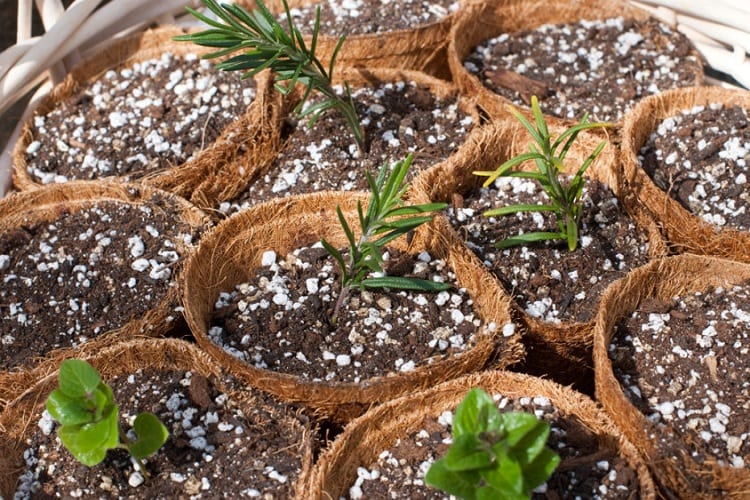
Soil matters in all types of gardening but when you’re dealing with a unique landscape like the city, it’s even more important.
If there’s any available soil or dirt where you live, you’ll probably want to avoid it and instead invest in some premium potting mix or soil that will facilitate growth better, as the local soil will be depleted of most of its nutrients.
The best soil for the job will depend entirely on what you’re growing, so once you’ve established that you can go ahead and choose. If you’re a newcomer to gardening, something simple like organic potting soil is best.
Avoid anything that’s too loaded with nutrients as it can be too much to handle at once, and instead, focus on developing a good fertilization schedule.
Fertilization Matters
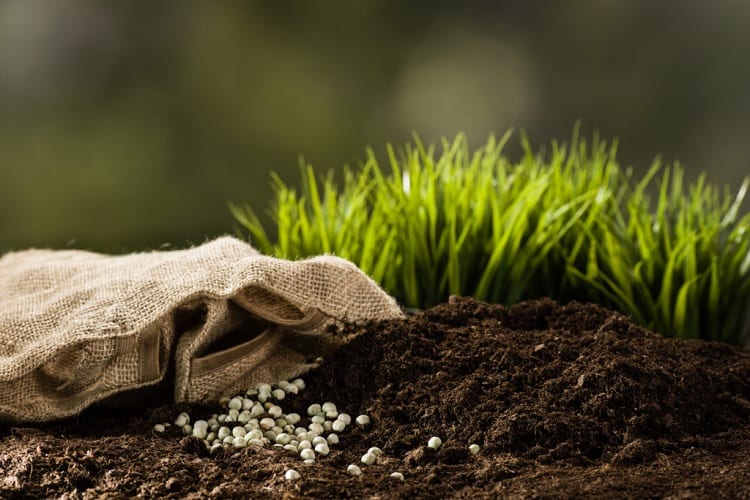
Fertilizer is an essential part of plant growth no matter when your garden is located.
When it comes to urban gardening, you’ll need to choose a fertilizer that best connects with the type of plant you’re growing, rather than the unique setting that it’s growing in.
For urban gardens and beginners, something like a liquid fertilizer is a good idea, and you can opt for an organic version made with fish content for the best results.
However, you’ll want to match a fertilizer to the pH levels and soil type once your skills grow a bit, and this will yield you greater results.
Most fertilizers come with directions on how often they should be applied, and it’s a requirement for all types of plants whether they’re in a container or a garden bed.
Fertilizer provides the food that plants need to survive and knowing when to do it is an exact science that is a huge element of successful gardening.
Gardening Laws That Might Apply
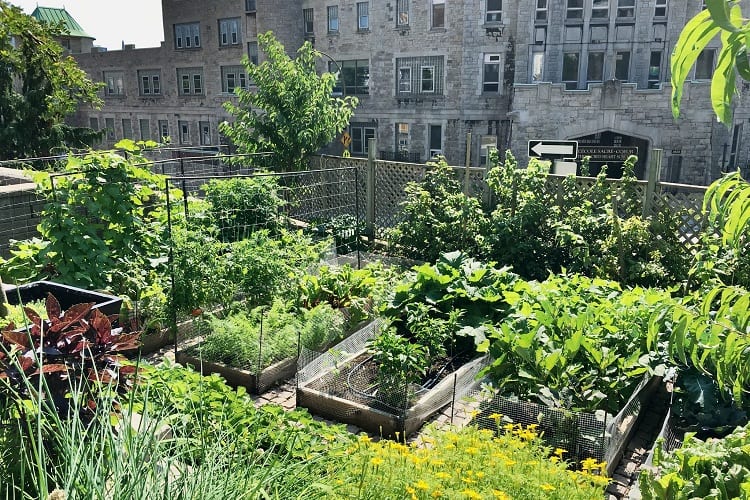
Urban gardening is easy enough to do when it’s situated on your balcony but if you have grand plans of spreading out further, you might want to check the local laws and ordinances first.
Most cities and states have laws that cover everything from compost to hedges, and you’ll want to make sure you’re not committing any crimes with your gardening plans.
Some ordinances include the growing of weeds, maintaining a compost pile, and the length of grass that’s allowed to grow.
You’ll have to follow the local laws in your city as well as any regulations put in place by the management of your building, and this should all be considered during the planning stages.
Tips for Starting an Urban Garden
With all of the benefits available, you might be eager to get started growing right away with an urban garden of your own.
Like all other types of gardens though, it’s best to have a plan in place, so follow these tips to help you start yours.
Look for sponsorship
Take time to speak to the community and see who might sponsor a city garden or neighbors who want to join in. there are many grants available for community garden setups that you can utilize, provided you can show some careful planning has gone into it.
Make use of shade and light
Look at the space you have and make notes during the day of where the sun hits, how long it’s there for, and what areas are shaded. Plan your garden layout according to these calculations.
Drainage matters
Drainage is imperative even in something as simple as a pot or container. Larger pots may need an additional layer of drainage like gravel or sand whereas small pots only need holes.
Start a compost pile
It’s worth finding a space to create your own compost pile if you have access to a city garden. Compost is an invaluable fertilizer and reduces waste if you encourage others in the neighborhood to place their food scraps there as well.
Use vertical space
Even the smallest balcony can have a thriving garden, provided you make use of vertical space. Invest in some structures and climbing plants for the best results.
Getting Green in the City

If there’s one thing our cities need more of, it’s green spaces, and being an urban gardener is a great way to add more greenery to your local area.
Even if it just means a few carefully placed planters on the balcony of your apartment, it’ll still make a difference.
There are so many great ways you can take advantage of the environment around you and use it to grow plants.
Even in an urban setting, you’ll see that with a little bit of planning it’s possible to have a successful and thriving garden, and a great way to insert some vibrancy and nature back into the city.
Related Questions
Urban gardening is just a fancy way of describing the act of growing plants in a city setting, but thankfully, it’s a buzzword that’s caught on and introduced many city dwellers to the wondrous act of gardening.
If you’ve been thinking about getting into urban gardening for yourself but still have more questions, read on for some FAQs that can help you out.
If you want to create a community garden in your local city, first consider the purpose and placement of it.
You’ll need to get approval from the council or local government and perhaps find a financial sponsor, as well as others who want to help you achieve this goal.
There is a lot of planning that goes into creating a community gardening space but it’s worth the effort.
There are many avenues that urban gardening can take so it depends on what space and resources you have available, your skills as a gardener, and the purpose you want the garden to have.
Options include smaller setups like herb gardens and balcony gardens, to large-scale configurations including rooftop and wall gardens or community plots started in the middle of the city.
Some people shy away from eating food grown in a community or urban garden but mostly, this produce is safe.
Be sure to thoroughly wash and clean any fruit, vegetables, or herbs you pick, even if you’ve grown them yourself, as the real danger can come with the soil that these plants were grown in.
Recourses:

